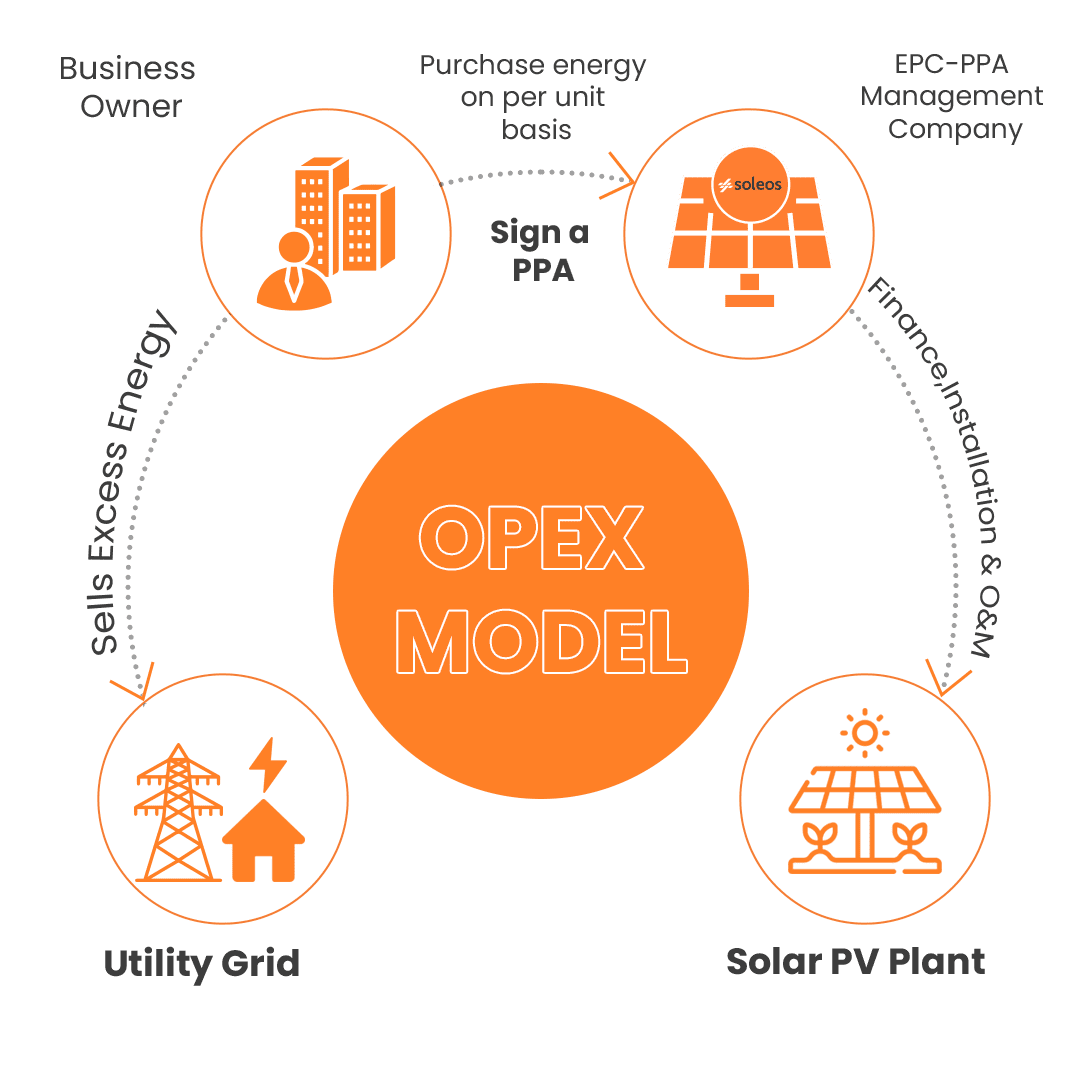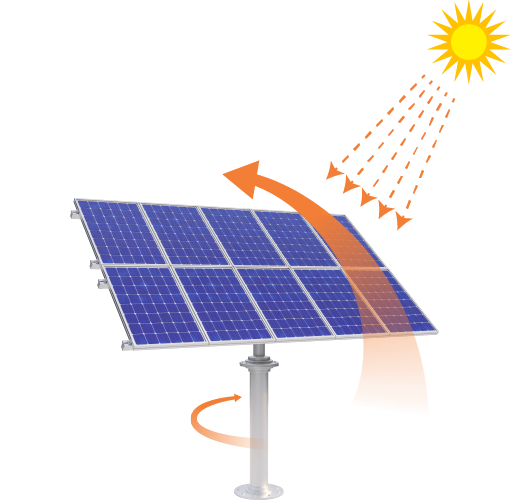India’s Ambitious Solar Energy Goals
The solar business model is crucial for determining how solar power plants function in India’s quest for a solar-powered future. This model specifies how income is earned, either by selling the energy generated or by using the electricity produced on-site and saving money. The solar business model affects many aspects, such as who owns the project, how much investment is needed, how operations and maintenance are handled, and what returns the stakeholders can expect.
As India makes significant strides towards its clean energy targets, currently boasting an impressive 72.31 GW of installed solar energy capacity as of November 2023, the journey is far from over. This is an impressive stride towards the initial target of 100 GW of solar capacity. Though the 100 GW mark has not yet been attained, India is not settling.
The country has set its sights even higher, aiming for a whopping 500 GW of renewable energy capacity by 2030. This includes all forms of renewable energy – solar, wind and more. As R.K. Singh, the Union Minister for Power and New & Renewable Energy succinctly put it: “We’ll hit that 500 GW well before 2030.“
This bold target reflects not only a numerical success but also India’s leadership in the global shift towards clean energy.
For businesses in India, the solar business model paves the way for financial incentives and opportunities, aligning seamlessly with the nation’s dedication to a sustainable and brighter future for all.
There are two main types of solar business models in India: the CAPEX model and the RESCO model. Each of these models has its own advantages and disadvantages, depending on the specific needs and preferences of the business owner.
CAPEX Model Explained
The CAPEX model involves the business taking full ownership and responsibility for the solar power system. This means the business purchases the solar panels, inverters, and other equipment upfront to install on their property.

The main elements of the CAPEX model include:
– High Upfront Investment: The business must pay the full capital expenditure (CAPEX) costs to purchase and install the solar system. This requires significant funds upfront but provides complete ownership.
– Long Term Savings: By owning the solar system, the business enjoys lowered electricity bills for decades. Once the upfront investment is recouped, the “free” energy from the sun provides excellent long-term savings.
– Full Control: The business has complete control over the solar system, panels, and maintenance. There is no third-party involvement.
– Tax Breaks: Government incentives like accelerated depreciation and tax credits provide financial benefits that improve ROI on the solar investment.
Overall, the CAPEX model is ideal for businesses focused on long-term savings, full control, and leveraging tax incentives. The major barrier is the large upfront investment required. But for some, owning their own power plant is worth it for decades of nearly free solar energy from the sun.
Pros of CAPEX Model
Ownership of your own solar power system through the CAPEX model provides some key advantages:
– Long-term Savings: By owning your own solar system, you can lock in low electricity rates for decades to come, insulating your business from ever-escalating grid tariffs and securing decades of free sunshine-fueled electricity. This gives you price stability and reduces your operating costs over the long run.
– Tax Breaks & Incentives: The government offers incentives like accelerated depreciation and tax credits to make solar power investments more lucrative. These can significantly boost your return on investment.
– Property Value Boost: Properties with solar power systems installed have higher valuation and fetch higher rents or sale prices. Going solar can directly increase the value of your business property.
– Control over the System: As the owner, you have full control over the solar power system installed on your property. You control all operations and maintenance and are not bound to any external party.
Cons of CAPEX Model
The CAPEX model requires a substantial upfront investment to purchase and install the solar power system. This can put a major dent in your capital expenditure budget. You’ll need to self-finance or take out a loan to cover these initial costs.
As the owner of the solar power system, you are also responsible for all maintenance and repairs. This includes regular cleaning of the panels, inverter checks, and any fixes needed over the 20-30 year lifespan of the system. Proper maintenance is essential to keep your system performing optimally.
There are performance risks associated with owning your own system. Factors like shading, soiling, inverter failure etc. can impact energy generation. You’ll have to shoulder these production and revenue losses when issues arise.
As solar technology improves over time, your system may become outdated earlier than expected. Upgrading to newer, higher efficiency panels down the line will add to your CAPEX costs.
So while the CAPEX model provides long-term savings and control, the burden of upfront expenses, maintenance, and upgrade costs rests squarely on your shoulders.
OPEX/PPA/RESCO Model Explained
The OPEX/PPA/RESCO model allows businesses to benefit from solar power without the major upfront investment required of the CAPEX model.

In this model, a third party such as a solar energy provider or RESCO (renewable energy service company) will finance, install, operate and maintain the solar power system on your property. As the business owner, you simply pay for the electricity generated by the solar panels based on a predetermined rate and term length outlined in a power purchase agreement (PPA).
Some key aspects of the OPEX/PPA/RESCO model:
– Third party ownership – The solar system is owned and operated by the service provider, not your business. This eliminates the need for any major upfront investment.
– Power Purchase Agreement (PPA) – A long-term contract to purchase the electricity generated by the solar power system, usually 10-15 years. The rate is lower than your utility but may be slightly higher than the CAPEX model.
– Operation, maintenance and performance – All responsibilities for operating, maintaining and ensuring optimal performance of the solar system lies with the service provider.
– Scalability – Businesses can easily scale solar capacity up or down through their PPA.
The OPEX model offers an accessible path to solar energy for businesses unwilling or unable to make major upfront investments. While you don’t own the system, it provides cost savings with minimal hassle.
Pros of OPEX/PPA/RESCO Model
The OPEX/PPA/RESCO model offers several key advantages that make it an attractive option for many businesses looking to adopt solar power:
No Upfront Costs
One of the biggest pros of the OPEX model is that there are zero upfront costs for the business owner. The RESCO handles the entire initial investment for purchasing and installing the solar panels and equipment. This allows businesses to avoid the huge capital expenditure required to buy their own solar power system. The business simply pays for the electricity generated by the system on a per unit basis. This predictable electricity bill each month is the only cost.
Low Maintenance
With an OPEX contract, the RESCO is responsible for all maintenance and repairs related to the solar power system. So the panels, inverters, wiring etc. are all looked after by the RESCO. The business owner does not have to worry about system upkeep or finding technicians to service the equipment as needed. This makes it a hassle-free arrangement.
Easy to Scale Over Time
A major advantage of the OPEX model is the flexibility it offers in system sizing. If the business grows and energy needs increase, it’s easy to adjust the PPA and add more solar panels to scale up power generation. There’s no need for the business to make additional capital investments to expand the system. The RESCO handles upgrading the equipment as required. This scalability makes it easy to right-size the solar system for current energy needs.
Cons of OPEX/PPA/RESCO Model
The OPEX/PPA/RESCO model isn’t without its downsides. Here are some potential cons to consider:
– Less control over the system: Since you don’t own the solar power system, you have less control over it. You can’t make changes or upgrades without approval from the RESCO.
– Potentially higher electricity costs: While you avoid the upfront investment, the electricity rates per unit could end up costing more over the long run compared to owning your own system. The RESCO needs to recover their initial investment and make a profit.
– Locked into a long term contract: OPEX/PPA/RESCO contracts typically range from 10-15 years – that’s a long-term commitment with little flexibility to change providers. It’s like signing up for a marriage to sunshine where divorce is not an option. Make sure you’re comfortable being tied to one RESCO for decades.
Choosing the Right Solar Business Model
When selecting a solar business model, it’s important to reflect on your budget constraints, risk tolerance, and long-term goals.
The CAPEX model may be the best fit if you want more control over your energy source along with tax deductions and incentives. Since you own the system under CAPEX, you benefit directly from government solar subsidies and accelerated depreciation. This allows you to maximize savings over the lifespan of the panels. Just keep in mind that the upfront costs will be higher and you take on more maintenance responsibility.
For businesses that want to avoid high initial investments, the OPEX model is very appealing. The third party finance provider shoulders the upfront panel and installation costs, so you can start benefiting from solar right away. However, electricity rates are slightly higher than the CAPEX model over the long run. And maintenance becomes the responsibility of the RESCO, not you.
Ultimately, choosing between CAPEX and OPEX depends on your budget, tolerance for risk, and goals for long-term savings or low initial outlay. Analyze your specific business needs to determine if the benefits of control and tax incentives outweigh the convenience and low startup costs. With the right solar model powering your company, you’ll be well on your way to joining India’s renewable energy revolution!
Investing in a Sustainable Future
With India’s ambitious solar energy goals, businesses have an incredible opportunity to invest in a more sustainable future. Going solar doesn’t just make economic sense; it benefits the environment and allows companies to demonstrate social responsibility.
Solar energy generates power without any air or water pollution, reducing dependence on fossil fuels. Widespread adoption of solar can significantly lower India’s carbon emissions and improve air quality. Businesses that install solar panels lead by example and show that profitability and sustainability can go hand in hand.
India is also demonstrating global leadership in clean energy through its massive push for solar power capacity. The country’s commitment to adding 500 GW of renewable energy by 2030 sets an example for nations worldwide. When Indian companies adopt solar, they become part of this clean energy success story.
By choosing solar, businesses can power their operations sustainably for decades to come. The sun provides an endless, clean energy source. Investing in solar technology allows companies to reduce their environmental impact and become stewards of a greener future.
Going solar makes sense financially and ethically. With two attractive models to choose from, every forward-thinking business can find a way to profit from the power of the sun while advancing India’s renewable energy revolution. Leading this sustainability drive will enable the country to shine bright as a beacon of climate action and progressive vision.
Contact us today at +91-8320095024 or visit www.soleosenergy.com to learn more about how to choose the best solar business model for your company! Feel free to reach out with any questions or to start your solar journey!

Take the next step in renewable energy by joining the Solarize Bharat pledge. Imagine your business not just as an entity benefiting from solar power but as a contributor to a nationwide movement, shaping the future of energy in our incredible nation.
Stay solar-powered and environmentally inspired!
P.S.: Share this blog with fellow solar enthusiasts to spread the word about the exciting world of solar energy!




